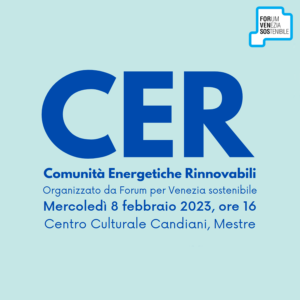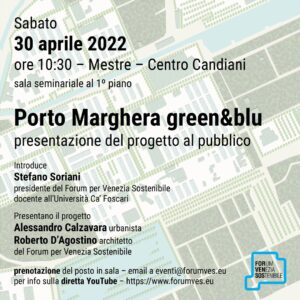Il presente articolo, riguardante il dibattito sulle CER avvenuto in data 8 febbraio 2023, è stato pubblicato originariamente nel giornale Gente Veneta in data 17 febbraio 2023. La riproduzione è stata gentilmente autorizzata.
Every euro invested in a renewable energy community pays back two. A little bit of a guess, of course, but that’s not too far from reality. Then, of course, one would also have to consider the environmental and social benefits…
But even standing on economic aspects alone, this is the bottom line when it comes to Cer: that is, precisely, Renewable Energy Communities.
The ratio of one to two, between money invested and money earned, comes out of the simulation presented by engineer Vera Manenti at the conference held on Wednesday, February 6, at the Candiani Center and promoted by the Forum for Sustainable Venice on the topic of Cer. A meeting that allowed to take stock of the Italian situation, characterized by a great delay in the implementation of the European Directive on Cer and by the bureaucratic and organizational difficulties that public and private actors encounter in the creation of these tools. New tools that are needed for the production, self-consumption and exchange of electricity from renewable sources. Not the least delay is that of implementation decrees, without which very few of these experiences can be launched. Not least because the ministry decree must set the incentive that will be paid, for 20 years, for all energy exchanged within a community. The trouble is that the Ministry of the Environment has been promising for months the release of the text, but it is still not there.

The simulation was done on the former Edison school and gymnasium in Marghera (near which the Caritas Pope Francis soup kitchen is operational). “It is a theoretical study,” specifies Eng. Manenti, who works at Imq eAmbiente, “intended to show how there is an opportunity to redevelop unused public or private buildings, even in the middle of our city. Here we are in the middle of a residential area, close to the industrial area of Porto Marghera.”
The study calls for the approximately 2,500 square meters of roof to be covered with photovoltaic solar panels, with a capacity of 264 kW. The required investment is estimated at 454 thousand euros.
The solar panels could produce about 334 thousand kWh per year: a considerable amount of energy that would allow – in Eng. Manenti’s hypothesis – first of all to operate the former school building should it be reused with some new function (consumption around 100 thousand kWh per year, a little less than 30 percent of production).
“Then,” Manenti continues, “we hypothesized involving another 64 utilities, broken down as follows: 20 low electricity-consuming households (around 1500 kWh in a year); 20 households consuming 2200 kWh; and another 20 consuming 2700. Plus four low-consumption businesses: a bar, a store, but certainly not a bakery, which needs much larger amounts.”
The 64 utilities would arrive at a consumption of 128 thousand kWh over the twelve months: this would be the energy shared in the Cer, for which a subsidy would be provided by the state (we speak of 11-12 euro cents per kWh) for the duration of twenty years.
The remaining energy produced would be sold to the national power grid (at a price estimated at 8-9 cents per kWh).
Over 30 years, a Cer organized in this way would produce 27 thousand euros in tax credits, 383 thousand euros in bill savings (the electricity produced with the sun and not purchased from the grid), 398 thousand euros in revenues from the sale of surplus electricity, and 286 thousand euros in contributions paid by the state for the energy exchanged within the Cer. For a total of 1.95 million euros.
It must be said that such an articulated Cer needs maintenance and management and therefore, over a 30-year period, there is a cost to be added, not estimated in the study presented to Candiani.
But nevertheless it is very close to the ratio mentioned: for every euro invested, two euros are gained. And that’s not counting the avoided carbon dioxide emission of 136 tons per year, equal to the amount of carbon dioxide produced by 63 medium-sized cars or the amount of carbon dioxide absorbed by 4500 medium-trunked trees, practically a forest. In short: it would be worth it…
Giorgio Malavasi


